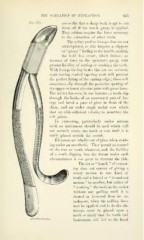Page 637 - My FlipBook
P. 637
THE OPERATION OF EXTRACTION. 635
Fig. 572. are SO flat that a sharp beak is apt to cut
them off, if too much grasp is applied.
Tliey seklom require the force necessary
iu the extraction of other teeth.
The writer prefers forceps that are not
nickel-phited, as tiiis imparts a slippery
or ''greasy " feeling to the handle, making
the hold less secure, which induces an
increase of force in the operator's grasp, with
greater liability of cutting or crushing the teetli.
With forceps having beaks that are not serrated,
teeth having conical tapering roots will prevent
the perfect fitting of the cutting edge ; these will
sometimes slip through the posterior opening of
the upper or lower alveolar j)airs with great force.
The writer has seen, in one instance, a tooth slip
through the beaks of an unserrated pair of for-
ceps and break a pane of glass in front of the
chair, and an under single molar root which
shot up with sufficient velocity to penetrate the
soft palate.
In extracting, particularly under nitrous
oxid, no instrument should be used which will
not securely retain any tooth or root until it is
safely placed outside the mouth.
Elevators are wholly out of place when work-
ing under an anesthetic. They permit no control
of the root or tooth whatever, and the liability
of a tooth slipping into the throat under such
circumstances is too great to warrant the risk.
The art or " knack " of extract-
ing does not consist of giving a
rotary motion to one kind of
tooth and a lateral or " in-and-out
motion " to another, but rather of
" working" the tooth in the socket
without any pulling until it is
started or loosened from its at-
tachment, when the pulling force
may be applied, and to do this the
forceps must be placed upon a
tooth so nicely that the tooth and
Alveolar forceps. instrument will feel to the hand


